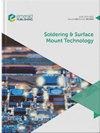Interfacial reaction between Ni particle reinforcements and liquid Sn-based eutectic solders
IF 1.8
4区 材料科学
Q3 ENGINEERING, ELECTRICAL & ELECTRONIC
引用次数: 1
Abstract
Purpose This paper aims to derive a model of growth kinetics of the intermetallic compound (IMC) layer formed in the reaction between liquid Sn-based solders and Ni particle reinforcements and to compare with the experimental data to verify the effects of Sn concentration and alloying element. Design/methodology/approach A composite solder was manufactured by mechanically introducing Ni particle reinforcements into a solder matrix. The effect of the non-reactive alloying elements, Ag, Pb and Bi, on the growth kinetics of the IMC formed between liquid Sn-based eutectic solders and Ni particles, reacting this composite solder at 250°C–280°C was studied. Findings Experimental results showed that only the IMC Ni3Sn4 was present as a reaction product. Using the diffusion-controlled reaction mechanism, a kinetic equation quantifying both Sn concentration and alloying element effects was derived and verified by comparing the kinetic data obtained using four different solders with different concentrations of Sn and the alloying elements. Originality/value The similarity between the activation energies of these four solders confirms that the diffusion of Sn atoms through the IMC is the rate-controlling step. Besides, the kinetic values are independent of the geometry of Ni, whether spherical particle or flat substrate.Ni粒子增强剂与液态sn基共晶焊料的界面反应
目的建立液态锡基钎料与Ni颗粒增强剂反应形成的金属间化合物(IMC)层生长动力学模型,并与实验数据进行对比,验证锡浓度和合金元素对IMC层生长的影响。设计/方法/方法通过机械地将Ni颗粒增强剂引入焊料基体来制造复合焊料。研究了非反应性合金元素Ag、Pb和Bi对液态锡基共晶焊料与Ni颗粒在250℃~ 280℃反应形成的IMC生长动力学的影响。实验结果表明,只有IMC Ni3Sn4作为反应产物存在。利用扩散控制反应机理,导出了量化Sn浓度和合金元素影响的动力学方程,并通过比较4种不同Sn和合金元素浓度焊料的动力学数据进行了验证。这四种焊料活化能的相似性证实了锡原子通过IMC的扩散是控制速率的步骤。此外,动力学值与Ni的几何形状无关,无论是球形颗粒还是平面衬底。
本文章由计算机程序翻译,如有差异,请以英文原文为准。
求助全文
约1分钟内获得全文
求助全文
来源期刊

Soldering & Surface Mount Technology
工程技术-材料科学:综合
CiteScore
4.10
自引率
15.00%
发文量
30
审稿时长
>12 weeks
期刊介绍:
Soldering & Surface Mount Technology seeks to make an important contribution to the advancement of research and application within the technical body of knowledge and expertise in this vital area. Soldering & Surface Mount Technology compliments its sister publications; Circuit World and Microelectronics International.
The journal covers all aspects of SMT from alloys, pastes and fluxes, to reliability and environmental effects, and is currently providing an important dissemination route for new knowledge on lead-free solders and processes. The journal comprises a multidisciplinary study of the key materials and technologies used to assemble state of the art functional electronic devices. The key focus is on assembling devices and interconnecting components via soldering, whilst also embracing a broad range of related approaches.
 求助内容:
求助内容: 应助结果提醒方式:
应助结果提醒方式:


